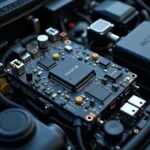Finding the best value for money car diagnostic tool can feel like navigating a maze. With so many options available, it’s easy to get lost in technical jargon and conflicting reviews. Whether you’re a DIY mechanic or a professional technician, investing in the right diagnostic tool can save you time, money, and frustration in the long run. This comprehensive guide will equip you with everything you need to know to make an informed decision.
Factors to Consider When Choosing a Car Diagnostic Tool
Before diving into specific recommendations, it’s crucial to understand the key factors that determine the value and suitability of a car diagnostic tool for your needs.
1. Vehicle Compatibility: Don’t Get Caught Off Guard
The first and foremost consideration is vehicle compatibility. Ensure the diagnostic tool you choose supports the make, model, and year of your car, or the vehicles you intend to work on. OBD-II scanners are standardized for cars manufactured after 1996, but for older vehicles or specific functionalities, you might require specialized tools.
2. Functionality: From Basic Codes to Advanced Programming
Diagnostic tools offer a wide range of functionalities, from basic code reading to advanced programming and module coding. Consider your skill level and the tasks you’ll be performing. If you’re primarily interested in reading and clearing check engine lights, a basic OBD-II scanner might suffice. However, for in-depth diagnostics, bi-directional controls, and special functions like ABS bleeding or key programming, opt for a more advanced tool.
3. User Friendliness: Intuitive Interface for Seamless Navigation
A user-friendly interface can significantly enhance your diagnostic experience. Look for tools with intuitive menus, clear navigation, and easy-to-understand data presentation. Consider features like touchscreen displays, color screens, and multilingual support for added convenience.
4. Software Updates: Staying Ahead of the Curve
The automotive industry is constantly evolving, with new vehicle models and technologies emerging regularly. Ensure the diagnostic tool you choose offers regular software updates to stay compatible with the latest protocols and functionalities.
5. Price and Warranty: Finding the Sweet Spot
Car diagnostic tools can range in price from affordable handheld scanners to high-end professional systems. Determine your budget and explore the features offered within that range. Additionally, check the warranty offered by the manufacturer, as it reflects their confidence in the product’s quality and durability.
Types of Car Diagnostic Tools: A Quick Overview
1. OBD-II Scanners: Your Gateway to Engine Insights
OBD-II scanners are the most common type of car diagnostic tool, designed to access and interpret data from a vehicle’s On-Board Diagnostics (OBD) system. They can read and clear diagnostic trouble codes (DTCs), display live data streams from various sensors, and perform basic tests.
2. Professional-Grade Scan Tools: Unlocking Advanced Capabilities
Professional-grade scan tools offer a comprehensive suite of functionalities, including advanced diagnostics, bi-directional controls, module coding, and special functions. These tools are typically used by experienced technicians and automotive workshops.
3. Mobile Device-Based Tools: Diagnostics at Your Fingertips
With the proliferation of smartphones and tablets, mobile device-based diagnostic tools have gained popularity. These tools connect wirelessly to your device, turning it into a powerful diagnostic platform.
Expert Insight: Choosing the Right Tool for the Job
“Investing in a quality car diagnostic tool is like having an X-ray vision for your vehicle,” says John Miller, a seasoned automotive engineer with over 20 years of experience. “It empowers you to understand the root cause of issues, saving you from costly guesswork and unnecessary repairs.”
Conclusion: Empowering Informed Decisions
Choosing the best value for money car diagnostic tool requires careful consideration of various factors, from vehicle compatibility and functionality to user-friendliness and price. By understanding your needs, researching available options, and prioritizing tools that offer a balance of features, usability, and long-term value, you can confidently invest in a tool that empowers you to diagnose and resolve car issues effectively.


